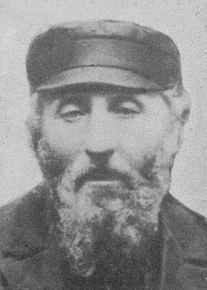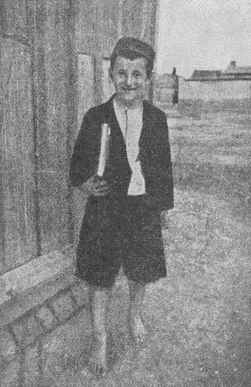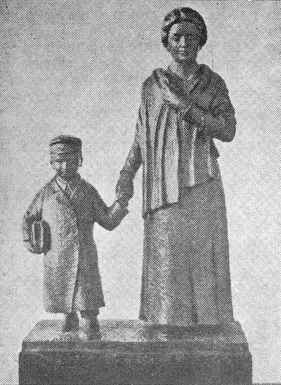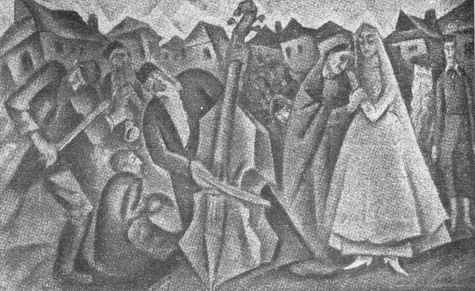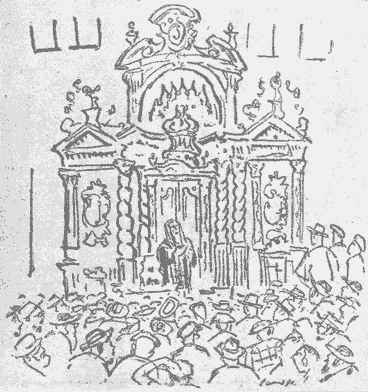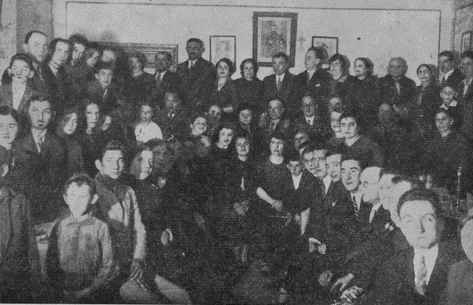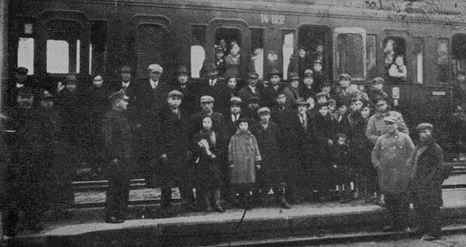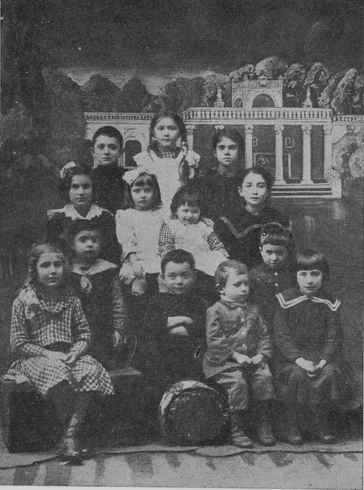Ostrów Mazowiecka
Images of Jewish Life
Klezmorim
By A.M - T
Translated by Howard Cherney
Szloime Klezmer [musician] (Wilenberg), with his band, was well known in the city. He was the first fiddler and leader of the well-known Jewish klezmorim [musicians] in the city: Szepsel Czernie with his son Welwel (now in Israel); Pejsach Klezmer, also Szaja-Jankiel Badkhen and later Isaac Badkhen son of Szloime Klezmer and others.
|
|
Szloime Klezmer |
Jewish klezmorim made Jewish celebrations cheerful. The musicians were very poor and had to earn their living from other regular occupations.
A Jewish heart goes out to a song, a Jewish soul is drawn to music as to a purifying spring, as is Jewish existence from day to day; Shabosim, Yontoyvim, the prayers, joys, troubles, are full of tunes and songs. Hasidim stretch out songs that are sung to welcome Shabes in the Shtiblakh Friday evening. For Hasidim a song is a part of life. Comes a bridegroom from the rabbi, he brings a new song, a melody he heard from a young man. He will be a song-master, can pray from the pulpit, which for the Hasidim is bound up with song. Misnagdim do not sing while praying, only Shabes songs. On Yontoyvim there would be singing before eating in every Misnaged home.
At the end of Shabes during a wedding week, just after havdalah, there is an outcry from the in-law's house for Szloime Klezmer and his band to strike up the tune a “Good Week”.
A lantern burns in the house, the table is covered again with the white Sabbath tablecloth, in-laws, good friends take their places. They sit down in their velvet hats, velvet caps, satin and silk coats or only in red, blue housecoats embroidered with various material flowers. Women were decked out in gold jewellery and silk, everyone drinks tea, the men chat, smoke cigars or pipes.
With time Szloime Klezmer, a tenor fiddler who grabs the hearts, appears. Szloime plays and Szepsel, Pejsach and Welwel accompany him, as well as his son Berel with the bass, Abraham with clarinet, Arcze with the flute and his son Izak Badkhen, all trying to make it happy, to play a joyful “Good Week” and “Mazel Tov”. But it is not joyous, the longer they play, the more tears are shed. They play with joy and instead it comes out sad, as all Jewish celebrations in the shtetl - the happy is also sad.
The host, a Hasid, wakes up first. He wants most to be free of the charming tenor. He stands up, thanks the musicians, they begin to play - everyone wakes up, wishes each other mazel tov, a healthy, full week. So begins a wedding week. Then comes the day of the wedding. The groom and bride fast. The mood in the house is festive. Syma the baker brings the smells of baking with him that fill the air. In-laws from a far, dressed during the week as if it were Yontef, are constantly arriving. On that day Szloime Klezmer and his band arrive early in the morning to strike up a tune for the bride Dzin Dobrai [Polish, “Good Morning”]. Everyone is crying with all those closer to the khupeh who are tearful, most tearful is the Bride, she must fast, pray from the Yonkiper prayer book. She must act as if it were the evening of Yonkiper, the day of her celebration becomes a day of tears, of tears gushing without end to remember the dead, the destruction of Jerusalem.
Despite that they eat, they drink, they dance, but something is missing. Isaac Badkhen calls the gift list with jokes, with funny expressions, and still it does not become joyous.
Such a wedding brings in enough for the musicians to live on for several weeks. In-laws pay, guests pay to have their requests played; they throw money for a dance. The “Broom Dance” [a man dances with a broom pretending it is a gun or a horse], the “Angry Dance” and the basic “Mitzvah Dance” bring in the most money.
In later times the musicians also played in the theater, in various performances and entertainment pieces from “Shulamit” and “The Witch”. Folk songs and foreign songs, obliterated by the Jewish version, were acquired and absorbed into Jewish celebrations and Jewish prayers. The Ostrower band also played at weddings in the surrounding villages and people also gladly hired them for gentile weddings, at a nobleman's in the manor courtyard. The gentiles liked Jewish songs and Jewish fish.
Translators Note: The Chernies mentioned are my family. Szepsel Chernie and his son Welwel are my father's uncle and cousin. The Pejsach mentioned could only have been my father, Sroel Pejsach Cherney. Welwel, who went on to play his fiddle in the Warszawa Symphony Orchestra survived the Holocaust and went to Israel with his children, where he joined the Haifa Symphony Orchestra. One of his granddaughters became a concert pianist in Israel.
Shabes Nahamu in the City
[The Sabbath after the 9th of Av.
Called the Sabbath of Comfort]
By A. M-T
Translated by Leah Krikun
Friday
A summery Friday afternoon! Young heder boys finish saying their haftoirah [lessons from the prophets], go through the weekly portion and set off for home with their prayer books, khumash and gemore to prepare for tomorrow's questions. At home the berries are picked and mother gives them the berries in a pot and their faces are soon completely smeared with the juice.
Mother takes the boots and kapote, locks them in the cupboard ready for tomorrow's prayers; children run out to the street barefoot and half naked; behind the school yard other children are already waiting. They run with bags filled with stones and chase away the baker's doves that fly around over the market, the baker runs out to chase them away, they pick up their feet and escape.
|
|
A good-for-nothing boy coming back from heder |
In the market there are already green apples, lovely pears - two groschen [pennies] for two. A young boy blows into the throat of a slaughtered duck and others follow. A girl runs past on her way to the rabbi to ask a question about a fowl. And here comes an older Jewish woman with a non-kosher duck on a plate, carrying it to the gentile baker. Fathers and little boys return from the barber with their heads clipped like sheep, in honour of “Shabes Nahami”. From the road, guests arrive in town for Shabes with packs on their shoulders.
On Friday the town comes alive, people are running, rushing, one can see that it is erev Shabes, the eve of a great day, even the sun sets over the town in a kind of Friday-like fashion.
The wealthy Nachman arrives at the market, hurrying home for Shabes. In the street there is a Friday atmosphere, the sky stretches so long and so wide, reaching for Shabes to arrive and as it gets later, more and more Jews appear in satin kapotes, in shoes and socks.
And the town becomes homey; craftsmen and artisans end their labours, youngsters grab beer money, run to the stores for collars and neckties.
The sun begins to set, it is evening and people are hurrying home. The last wagon drivers arrive. The women selling at the market place pack up their merchandise and bring it home. Children, after their bath, run through the street with flasks to Mosze Chaim Wejnmacher's to get wine for kiddush. The shops close, one by one. The darkening sky settles over the town. The knocking (on the doors of the homes) to go to the synagogue begins and in a few windows Shabes candles can be seen, in front of some houses the homeowners appear with their daughters, washed and combed in honour of Shabes and sit by the door.
It is quiet and peaceful in town. Shabes arrives with quiet steps and spreads rest. The men, after their bath, with white shirt collars over their Shabes kapotes enter the synagogue; Hasidim in silk and satin, shoes and socks - go to the shtiblakh. Through the clean windows, candles flicker in candlesticks. Young girls appear in the street, going for a walk.
Nachman and his intended son-in-law appear in the street. They are going to the besmedresh to pray; on the doorstep and nearby, young girls appear and whisper: Chanele's groom... young ladies - brides walk on the synagogue street wearing gold chains with watches that they received from their in-laws as wedding presents.
Friday night: In Nachman's home, in honour of the groom, the table has been laid in the large dining room, its leaves open, something that is done only once every year, for the Purim banquet, when all the children and grandchildren gather together. Perele did not spare any lighting. She has read and knows well that the more light there is, the better livelihood is granted by God. The large table is decorated with silver candlesticks.
Lit by the candles, everything in the house shines. In honour of the groom the silver spoons, forks and knives have been taken out and the silver wine cups at the head of the table are covered with a cloth that Chanele embroidered in silver for her groom. Perele is wearing her white satin dress with gold garniture underneath, and a silk shawl, which her husband brought her from the Leipzig fair.
Chanele, after her bath, with her long blonde braids lying loosely over the blue silk jacket, looks like a young girl who obeys “what father, mother and good religious people tell her” - a blessing and peace rest upon her head. She sits next to her mother and reads the “Tekhina” with her. “Great God, may my good deed of lighting the candles be received like the good deed of the high priest when he lit the candles in the Holy Temple, so my children's eyes will shine inthe holy Torah and their luck light up the sky...”
Nachman has come home after prayers and a rather large number of guests followed him. Gut Shabes! “Shalom Aleichem, Shabes angels, Angels from above...” And it was seen how the angels with their white wings spread peace and rest around the house. Perele and the bride sit by the table, waiting for the blessings over the wine and bread, and the men again speak the traditional words “a righteous woman who will find”...
People sit at the table. Nachman is at the head with the groom opposite his wife and the bride. All is quiet.
Every few moments Chanele slowly lifts her eyes and glances at her groom, in the silk kapote, so full of charm. She notices his gold watch - the watch he received from her, he is her groom...
He sits quietly, his eyes downcast.
Quiet. The father and the groom start to sing, his voice rings resoundingly, “rest and joy, light to the Jews”.
She, the bride, serves the food, puts a plate in front of her father, her mother, and him...
In the midst of their meal the in-laws Joel, his wife Rejzel with Icchok, Berl, Riwkele and Cypele arrive with their children, with other relatives and acquaintances.
“Shalom aleichem” is said to the groom, he is asked how he feels, someone says a few lines from a song, the groom replies with a little tune. Everyone in the street comes running to stand under the windows. They stick their heads in: Gut Shabes, Gut Shabes. The door is opened and strangers begin to sneak in and fill up the house. Wine is served one glass after another. It is dark outside. The stars deeply imbedded in the deep blue sky, look like Shabes candles in a Jewish home, here and there a Shabes candle still shines, on the verge of going out.
Shabes
Shabes morning, the sun rises in the sky and the bright day stretches over the town. The shops are closed, locked. A man is standing by the door of his home, yawning freely and openly at the world, there goes a Hasid who just left the mikveh and drops of water are running from his wet payos onto his freshly laundered shirt. The women, dressed up, begin to make their appearance (Jewish children love to change outfits from one Shabes to the next) in beautiful silk dresses, wrapped in a “Turkish” scarves that used to be called “synagogue scarves”. Young wives with silk shawls from Leipzig, young girls wearing shoes that have been shined for Shabes, wrapped in shawls, stand in the doorways, by the windows, and look on. The young boys carry prayer books with Tekhinas, for their mother or their aunt, tied up in a handkerchief.
|
|
A young boy carries his mother's Sidur |
One sees Jewish men in their Shabes kapotes, clean boots, shirts and collars. Some are wearing their prayer shawls, some children are carrying prayer shawls and the khumashim, Hasidim in satin kapotes, some entering, some leaving the mikveh. The street has become lively, homey and more Sabbath-like, the sun lights up the sky - fresh, bright, a new appearance for Shabes.
In the besmedresh people are already praying, the cantor has prepared new “pieces” for the people. The cantor and the choir of young boys with squeaky voices, are having a good time, making the people laugh and cry, and carry their prayers up to the sky.
Nachman and the groom arrived here a bit late, but this is suitable behaviour for a groom. He is honoured by being asked to recite the weekly prayer, the women in the balcony of the besmedresh look down, listen to the groom reciting the weekly prayer.
After prayers, Nachman invited everyone for kiddush. Perele was beaming with delight. Her home was filled with so many upstanding people, pious men and teachers. She served the fish.
Singing began and there was a feeling of joy. Everybody took places at the table. From the whole town people started to bring kugel [a traditional Shabes noodle pudding] for the groom. “Mama sends this kugel for the groom” – say the young girls carrying in a platter covered by a second plate and decorated with a serviette.
“Thank you very much” - the mother says - “G_d willing, your groom will sit at the table, and we will send flasks of wine!”
In the street everyone is in the mood to celebrate. People are still sitting at the table. From some windows the typical sound of the day of rest is heard - some of the men have fallen asleep at their prayer books while saying the blessings.
As was the custom on Shabes, after the meal one slept a while. Perele did too. Chanele, wearing a Shabes dress with a white bodice, went into the living room and like a “modern” bride sat by the window to read a book. “He” paced the living room, somewhat bolder, somewhat more at home. She continued reading and his “presence” didn't disturb her, or embarrass her. Both were silent, feeling like a bride and groom.
Dressed-up young girls walked in the street and glanced at the window, they wanted to see Chanele's groom.
In the afternoon people studied. Nachman, as was his custom, studied midrash and other holy books. The grandchildren began to arrive and Nachman listened to the youngsters recite the weekly portion, and the gemore of the older boys. Grandmother served the Shabes fruits.
The groom sat studying on the other side of the table, reading aloud from the long gemore, absorbed in his learning. Perele and the mother-in-law sat on stools in front of the door, with the daughter-in-law and daughter, in silk and satin, wearing gold chains and watched the people walking. The sun began to set slowly, quietly, in a Sabbath-like fashion. The Jews started home for the third meal, walking together and talking.
It is dark - here and there a lamp sends out its rays through a dark window and lights the area.
In the street one hears melodies from the small shtiblakh, where men sat at tables for the third meal. The street was a different world, a sense of longing clung to the street. Then the moon made its way between the dark clouds and swam into sight so clearly, so brightly, as if to wish everyone “a good week”...here and there little groups of Jews stood and welcomed it.
The Wedding
A few days after the snow began, the town was entirely covered. The moon appeared on a pleasant evening, made its way through the clouds and lit up the town, so that the children who left heder with their lanterns lit, used the light more for illumination than to show the way home. Together with the moon, the stars appeared and lit up the snow.
In town there was a homey, warm atmosphere, a joyous occasion; the wealthy Nachman was marrying off his youngest daughter Chanale.
|
|
A wedding in the shtetl |
Guests, wealthy people, the pious and the irreligious came to the wedding. The entire town was full of in-laws, relatives, people riding on sleighs with bells ringing and the boys in the street climbed onto the sleighs by grabbing on from underneath and there was a racket, a lot of noise.
Hasidim with hats of all kinds: silk, satin and fur; the women relatives wearing wide head bands and high caps with ties and silk, wide skirts. Impatient mothers are standing in front of the doors, wearing their chains and broaches and waiting for the sleighs that had been sent to take the guests to the wedding.
Young girls are wearing fancy white dresses, blue ribbons and white shoes and in their hands, silk purses with their dance-money. The young men approach the groom to receive and welcome him. Young boys with skullcaps appear, young girls with combed hair. They are accompanying their mothers to the wedding.
Music can be heard in the street, people are dancing in the snow, youngsters are making snowballs, preparing for the moment when the bride and groom are led to the khupeh in the besmedresh courtyard.
Hasidic melodies are heard in the street. Szlojme's fiddle is wailing, and the orchestra of his son Berl with the bass, Abram'cze with the clarinet and Szepsl with his sons and their fiddles, as well as Pejsach with his fiddle.
Candles and lamps appear in windows, the streets become bright, clear. Women stand at the door with candles in their hands. The flames blaze. The bride and groom are led to the khupeh in the synagogue courtyard. They cover their eyes with handkerchiefs.
The male relatives from both sides of the family accompany the groom and the women lead the bride. The musicians are playing gay music; the fiddles, bass, clarinet, trumpet and cymbals join in harmoniously and together with the badkhen, Szaja Jankiel, they entertain the audience.
Rosh Khodesh Elul
By A. M-T
Translated by Leah Krikun
The days of Elul are arriving in the shtetl, visitors appear who have not been seen for an entire year, visitors carrying packages containing tsitsis and various amulets, visitors with beautiful beards, devoted people with writings in their hands.
There is a warm, friendly atmosphere in the besmedresh. Booksellers with various holy books, Tekhinas, prayer books, they lived in the besmedresh, near the oven, spread their wares out on tables, the youngsters grabbed money from their mothers; the boys to buy a siddur or makhzer; the girls - for storybooks.
The wives sit in front of their doors knitting socks. They hear the voices of little children sitting in their school rooms, learning the holy Torah and they remember the saying “by virtue of the little children”...the sound of a shofar is heard. The blast shakes the air and causes everyone, young and old, to tremble.
Distant aunts, nieces and nephews arrived in wagons. They go to their parents' graves, seeking their departed fathers, mothers, in the cemetery.
Here and there people are hidden among the gravestones and a quiet weeping is heard in the wild grass; the cemetery caretaker leads a woman showing her where her father's bones lie at rest, and he says the prayer “G_d Full of Mercy”.
The Jew from Israel also arrived to gather money from the pushkes, on the door near the mezuzah, in every Jewish home. Every mother, when she lit the candles, put “candle money” into the box. A tall, thin man with a pale Day of Atonement face, a white satin loose cloak and long black ear locks, sits in the besmedresh surrounded by a number of old Jews, who for a long time have possessed small bags of earth from Israel. The old men listen carefully to what the man from Israel is saying about the “old mother”.
From his package he takes out earth from the grave of Rachel, that he visited on his way to Efrat, as it is written in the Bible that our forefather Jakob buried Rachel on the way to Bethlehem.
And the Jews remember the melody of the song “When I Came To Padan-Aram, the Mother Rachel Died”. And the old men felt a longing and there were tears in their eyes.
Evening came, a cold wind howled in the street. An old man wearing a winter coat was going to the besmedresh for afternoon prayers; the artisans left their work and went to the besmedresh to read a chapter of Psalms between afternoon and evening prayers – Rosh Khodesh [beginning of the month] Elul.
One side of the sky was lit with a bright red, hellish fire: the evil ones were being burnt; on the other side a quiet, pious, earnest cloud spreads out, looking like good angels enveloping and protecting the town.
The besmedresh is packed with young and old Jews, embraced by the warmth. A magid stands on the bima and lectures about morals, reminding everyone that they are God's children and they felt like children - weighted down in the Diaspora - far from their father in heaven. After the sermon they began Ma'ariv. “The almighty will take pity and free us from the Diaspora. Everyone stood for Shmone Esreh. It is almost dark and the candles are flickering. Someone sighs “oy, father”, a sigh torn from a broken heart and the quiet people, as though in agreement, sway to and fro.
|
|
A magid stands on the bima giving a sermon |
Mr. Arija Margolis' Aliyah to Israel in 1935
By Israel Sztejnberg
Translated by Judie Ostroff Goldstein
The aliyah, of a Zionist volunteer, brought joy (mixed with a little envy) to all the Zionists in Ostrowa. No wonder! At this time, there were only a few certificates available. Even halutzim who had completed hakhshara were on a waiting list for years. Therefore, a volunteer's departure to Israel was an event. The news about Arija Margolis' aliyah was a joyous occasion for his friends – and he had a lot of friends. He was accepted by all Zionists, whatever their affiliation, because of his liberalism and generosity and was a representative of all the Zionist agencies in Ostrowa and was known by all the workers. He gave heart and soul to the day to day running of the National Funds (Keren Kayemet and Keren HaYesod). He was the deputy for Keren Kayemet for many years and the head of the executive committee for Keren HaYesod. Not only was he the leader, but he often took care of the difficult day-to-day “dirty” work. Therefore, the news that Arija Margolis' life long dream of making aliyah had come true brought great joy to all the volunteers, but they were also worried about the fate of the National Funds. Besides his house being used by the committee and as a meeting place for the volunteers, it would be truly difficult to part with such a devoted Zionist.
|
|
Farewell part for Comrade Margolis before he left for Israel |
There was a large number of colourful people at his farewell party – Zionist volunteers, community workers and many friends. The farewell party turned out to be a large Zionist demonstration. During the evening Arija Margolis turned over all the material in his files. This was truly a National archive. I expressed my admiration for the collection and wondered how a person could find the time, energy and patience to file each document, circular, letter, protocol and announcement with such reverence and order. The archive clearly reflected Zionist activity in Ostrowa for period of over twenty years. To our great sorrow, the archive perished along with the dear volunteers whom had taken it over.
I would like to mention an episode that occurred during the gathering before his departure: Mosze Dawid Jagodnik said to Margolis: “ If you are worried about the journey, maybe you should not go? Give me the certificate and I will go!” The answer was: “I am not worried about the journey, only about you remaining in exile”…
|
|
The farewell at the train station |
Arija Margolis departed in grand style, with several droshkys driving the family to the train station. Volunteers, friends and a lot of ordinary Jews, who during an emergency had turned to the social institutions where Margolis was a representative, walked. These poor, simple Jews were moved to tears.
In November 1935 Margolis left for Israel where he continued his work for Keren Kayemet for many years.
The Margolis home in Israel also became a gathering place for Ostrowers, mainly for the newcomers, survivors of the terrible Holocaust. During the bloody war years, Arija Margolis did not rest. He organized help for Ostrowers in Siberia and the Taiga in the Soviet Union. He searched for relatives of these Ostrowers and his home was truly “Ostrowa House”.
These last years he devoted his energy and time to the Yizkor Book, the memorial to the Jewish community of Ostrów Mazowiecka and those who were tragically and violently murdered. Arija Margolis was and still is a dear son of the Jewish community of Ostrów Mazowiecka. Let us wish him good health and long life.
|
|
A group of young children from the “old country” |
